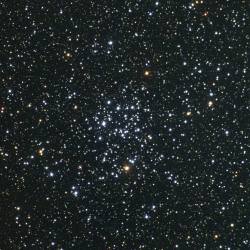For urban and suburban dwellers, practicing binocular astronomy can sometimes be discouraging because of the lack of faint marker stars to help locate deep sky objects. Right now, early evening dark skies are the perfect opportunity to spot the brightest star in the night sky – Sirius – and let it lead you on to some deep sky gems! So print off this article, grab your binoculars and a good friend and get outside!
Just after sky dark, head outside and look basically south for the “Scorching One”. Even if you don’t use binoculars, this 8.6 distant light year beauty sparkles and twinkles like a true diamond. Even though it’s only the atmosphere which causes the effect, Sirius’ beauty has been noted throughout ancient history in both culture and mythology. Small wonder, it’s twice as large as our own Sun and 25 times more luminous! One of the earliest star charts done by Ptolemy recorded Sirius’ position and in 1676 Edmund Halley noted its movement. While today we understand that stars with large proper motion mean they are closer to us than further away, it was definitely an eye-opening experience for early astronomers.
Now, open your eyes wide by using binoculars of any size and center on Sirius. Move slowly south about one average binocular field until you see a compression of stars. Congratulations! You’ve just spotted Messier Object 41. As incredible as it may seem, this bright cluster of stars may have also been noticed by Aristotle as far back as 325 BC… without modern optics! Spanning about 25 light years across, there are about 100 stars which are true members of the cluster. if you thought Sirius was bright, then take a close look for a reddish central star. It’s 280 times brighter yet than Sirius! Thank heavens it’s about 2,300 light years away or there would be no such thing as a “dark sky”.
Now head back to Sirius and let’s take a hop Northeast just a little more than two binocular fields. Do you see that small heart-shaped collection of stars? It’s Messier Object 50. Although this galactic cluster contains about twice as many stars as M41, they are so faint they are difficult to see from light polluted skies. If you have larger binoculars, you can probably even spot some color differences between members.
Let’s get Sirius again. This time we’re headed almost due east about another two binocular fields. Messier Object 47 is quite bright by comparison, and with good reason; it’s much closer than the other two clusters. This time we’re only looking about 1,600 light years away. Like its other two star-studded companions, it’s about the same age, but has fewer stars. This particular cluster curiosity was an instance where Charles Messier messed up. He recorded its position wrong! For now? Have a look around. These bright clusters are easily seen from most locations and all you have to do is…
Binocular astronomy: Get Sirius!


My idea years ago for ‘binocular’ lunar photography was to take a pic of the moon after sunset, then take another pic of the moon hours later before sunrise (with the same visual registration) to capture a 3-D image of the moon with an ‘interpupilary’ distance of a few thousand kilometers. This would yield a starkly natural 3-D view of the moon.
Canis Major is such a wonderful constellation for binoculars. M41 has always been a favorite of mine. I recorded NGC 2360 in Canis Major for my Binocular Deep Sky quest last Friday night. A great article, Tammy.
Thanks Tammy. Great article. I’m linking for my Scouting blog
http://mangsbatpage.433rd.com/2008/03/article-on-binocular-astronomy.html
When our club. The Brazosport Astronomy Club, does a star party at our local area elementary schools, I always take my binoculars. Kids go wild with a simple pair, and always are amazed. Binoculars are more available to use then most of the telescopes they see used by adults. I always like to inspire them to just use the simple tools and start SEEING. Thanks Tammy for a good article.
Thank you, some of us just need a little direction, to realize what we are looking at.
Appreciatively…..
I forgot to add that binoculars are under appreciated. Beginners want telescopes because they think they are cool.
The advice I give (see link) is not new but is probably the best way to get started and have fun watching the sky.
http://mangsbatpage.433rd.com/2007/11/your-first-telescope.html
Besides, why settle for one when you can have two!
Thanks, folks!
I look forward to posting more observing articles for binoculars and especially those which make it easy for folks who don’t have the darkest of skies to easily find things.
If you don’t have a pair of binoculars, may I suggest you check out OPT? Another good resource for binocular friend maps is also Google Sky. Watch your magnitude listings! Most smaller binoculars can easily see magnitude 6 and sometimes 7 from urban locations and up to around 8 for 50mm or more in aperture.
Best,
~Tammy
thanks for helpping me with my science curent events!!!